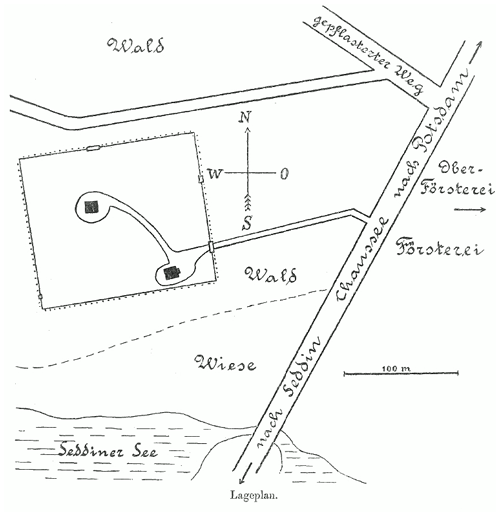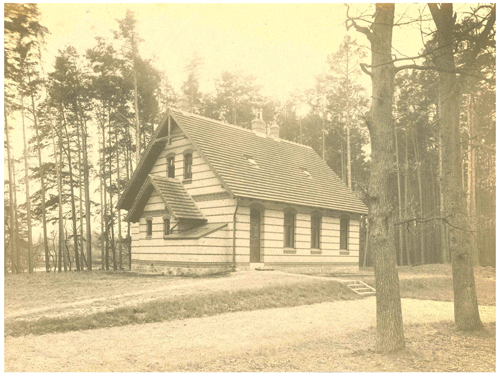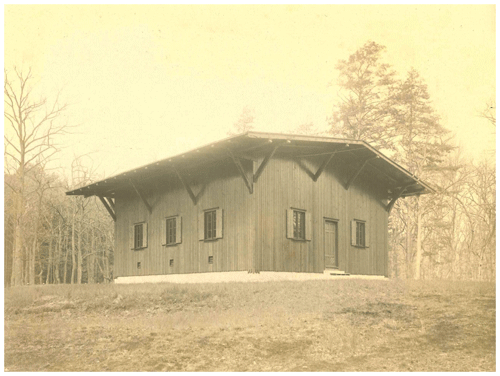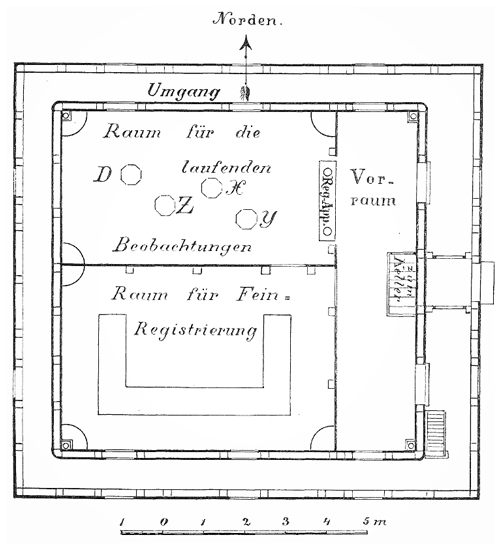the Creative Commons Attribution 4.0 License.
the Creative Commons Attribution 4.0 License.
History of the Potsdam, Seddin and Niemegk geomagnetic observatories – Part 2: Seddin
Hans-Joachim Linthe
The measurement series of the three geomagnetic observatories Potsdam, Seddin and Niemegk spans 130 years, starting in 1890. It is one of the longest, almost uninterrupted series of recordings of the Earth's magnetic field. Data users frequently emphasise the high quality of the data and their significance for geomagnetic base research. Very well known outstanding geomagnetism scientists, such as Max Eschenhagen, Adolf Schmidt, Julius Bartels, Gerhard Fanselau and Horst Wiese, directed the observatories during their existence. This paper describes the history of the Seddin Observatory, which was in operation from 1907 until 1932.
The magnetic observatory of the Potsdam Prussian Meteorological Magnetic Observatory has been in operation since 1890 on the Telegrafenberg nearby the town of Potsdam. In 1904 the town of Potsdam planned the electrification of the Potsdam horse tramway. Similarly, for the nearby Teltow Canal, constructed 1900–1906, a towing by electrical locomotives was intended to be used. Due to running both the rail establishments by DC power, the influences of leakage Earth currents on the magnetic observations seemed to be inevitable. The relocation of the Potsdam Observatory became inevitable (Schmidt, 1910). It was decided to establish an additional station for variometer recordings at a location at a secure distance from the DC-powered railway traction vehicles (Linthe, 2023a).
Test recordings 13 km south of Potsdam nearby the village of Seddin, performed from June–December 1906 (Venske, 1909), proved the applicability of the location for a sub-observatory free of technical noise, which was established approximately 180 m northward of Seddin Lake and 250 m westward of the Potsdam–Beelitz road. Its operation started in 1907. Adolf Schmidt successfully acquired the funding for the sub-observatory from the Teltow Canal Society.
2.1 Seddin Magnetic Observatory buildings
Figure 1 shows the ground plan of the Seddin Observatory. The compound was a rectangular, fenced area of about 150 m by 130 m (Schmidt, 1908). A massive house containing two offices and two accommodation rooms was constructed nearby the south-eastern corner of the compound for service. Figure 2 shows its photo.
The ordinary observatory building was located slightly displaced in a north-west direction from the centre of the compound. The wooden building rested on a basement made from non-magnetic limestone. The pillars for the instruments consist of the same material as the basement. Any fitting assemblies are made from brass; the nails are copper ones. Figure 3 shows a photo of the observatory building.
Figure 4 depicts the ground plan of the observatory building. The building is oriented geographically. The circumferential corridor (Umgang) protects the instrument rooms from outside temperature variations. The loft and the big projection of the roof shields the walls from solar radiation (see Fig. 3).
The photographic recording equipment (Reg.-App.) was to be handled from the vestibule (Vorraum). Its sketch is shown in Fig. 6. Two instrument rooms are available. The instruments for the current observations of the declination (D), vertical intensity (Z), and north (X) and east component (Y) were placed on separate pillars in the northern room. In the southern room a horseshoe-shaped table, resting on several pillars, was available for temporary placement of portable precise instruments. The building did not have any heating. At a distance of 15 m from the building in a northern direction, a pillar was constructed for absolute measurements.
From the beginning, it was intended that a building would be constructed for absolute measurements. Negotiations with the town of Potsdam to provide the necessary funding seemed to result in a successful result in 1913, but the begin of World War I blocked this plan.
In 1925 the service house was enlarged; a small store shed and a wooden house of 5.8 m by 4.3 m floor space and 5 m height were constructed for absolute measurements. The former outdoor pillar was encased by the absolute house, and a second pillar was added inside (Venske, 1927). Absolute measurements were performed in August 1926 and from July 1928 onward in this house. An azimuth mark target was fixed at the service house. The azimuth value was determined by means of solar observations.
After the termination of the observations in Seddin from 12 May 1932 onward, both wooden observatory buildings were removed, transported to Niemegk and rebuilt at the location of the new observatory (Nippoldt, 1933, 1934). Unfortunately no photo of the absolute hut at its original location exists. Figure 5 shows a photo of the “small hut” at its present location in Niemegk. This photo was taken in 2005 after comprehensive renovation.
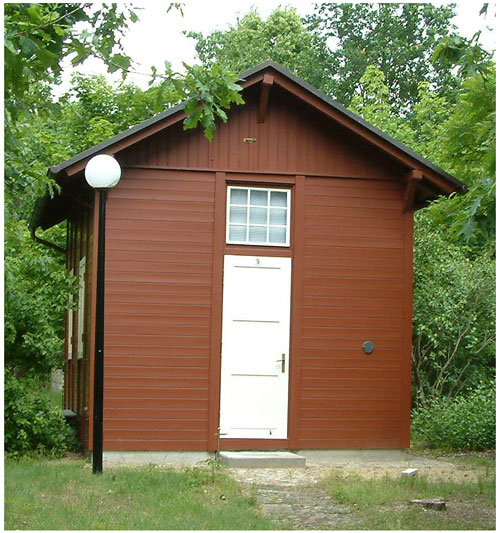
Figure 5Absolute hut of Seddin Observatory after its relocation to the present location in Niemegk and renovation in 2005. Source: Helmholtz Centre Potsdam – GFZ.
The service house still exists. It was handed over to the forestry administration.
2.2 Observatory instruments
As already mentioned, Seddin Observatory was mainly in use to record variations of the Earth's magnetic field. Due to the termination of the observations in Potsdam in 1928, the absolute measurement instrument set was moved to Seddin.
2.2.1 Variation recordings
The recording equipment had four drums for recording the variations of the declination (D), north component (X), east component (Y) and vertical intensity (Z), driven by joint clockwork. It was installed in the wall between the vestibule and the instrument room (see Fig. 6). So any handling of it, such as the change of the photographic paper, was possible without entering the instrument room. X, Y and Z were recorded generally and D only occasionally. Two petrol-burning lamps (one for X, Y and Z and the other one for D) produced the light for recording.
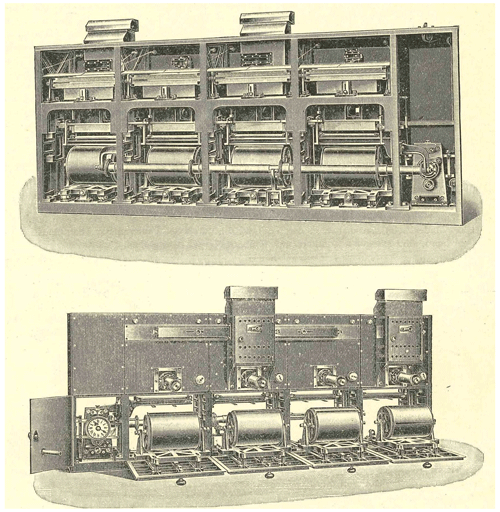
Figure 6Recording equipment of the observatory building northern room. View from the instrument room (top) and view from the vestibule (bottom). Source: Schmidt (1910).
The variations of the two horizontal components X and Y were recorded by means of identical magnetometers, based on suspended magnets, while the vertical variation was recorded using a magnet mounted on a balance. Figure 7 shows views of the horizontal magnetometer (left) and the vertical one (right). The Helmholtz coils mounted at each magnetometer allow the galvanic determination of the scale values. The magnetometers and the recording equipment were made by the well-respected enterprise Otto Toepfer & Sohn, Potsdam.
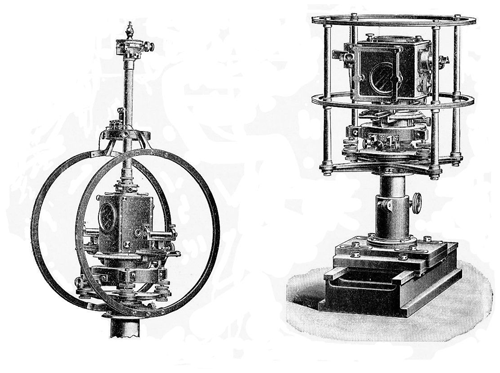
Figure 7Upper part of the horizontal magnetometer (left) and the vertical one (right). Source: Schmidt (1910).
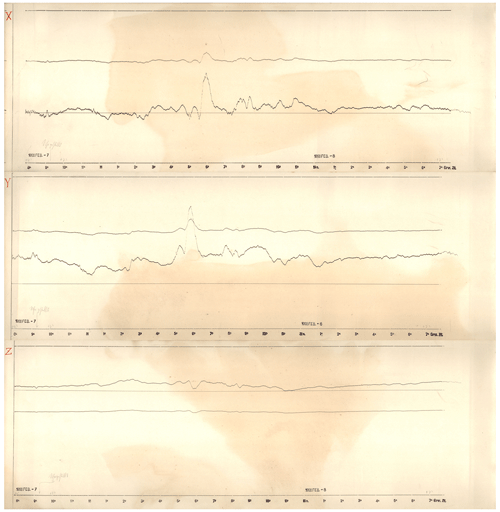
Figure 8Seddin Observatory photographic recordings of the north (top), east (middle) and vertical component (bottom) of the time interval of 7 February 1908 at 08:00 till 8 February 1908 at 08:00 (Greenwich civil mean time). Source: Helmholtz Centre Potsdam – GFZ.
The Seddin photographic recordings of each component contain a baseline, two tracks of different projected sensitivities (2 and 8 nT mm−1) and the temperature track. The baseline was interrupted at the beginning of every hour for 3 min to show the persons using the recordings the beginning of the hour; this was controlled by a non-magnetic pendulum clock. The two tracks of different sensitivity ensure the acquisition of the variations of the Earth's magnetic field in the case of lower or higher magnetic activity (Schmidt, 1910). Figure 8 shows the photographic recordings of the north (X), east (Y) and vertical component (Z) of 7 February 1908 at 08:00 till 8 February 1908 at 08:00 (Greenwich civil mean time).
The instruments and recording equipment, operated in the south room, were changed from time to time. An instrument set of decreased sensitivity allowed the depiction of the magnetic variations on the usually used photographic paper in the case of magnetic storms. In 1928, finally a variometer set was installed for recording of the declination (D) and the horizontal (H) and vertical intensity (Z), made by Askania, Berlin1, and photographic recording equipment, made by Otto Toepfer & Sohn2, Potsdam, as a backup system.
2.2.2 Absolute measurements
Absolute measurements took place in 1908 at the outdoor pillar and in August 1926 at the two pillars in the new absolute house by means of a set of journey instruments to compare the absolute levels of Potsdam and Seddin Observatory. In 1928, the Wanschaff theodolite was installed on one of the two pillars, and the associated oscillation box found its place on a wooden tripod in the absolute house for the further measurements of D and H in Seddin. The Schulze no. 652 Earth inductor, installed at the other pillar, was in use for the measurements of the inclination (Nippoldt, 1931). From the beginning of the year 1930, the Schulze no. 1 Earth inductor was moved from Potsdam to replace the no. 65 one in Seddin.
2.3 Operation of the Seddin Observatory
Seddin variometer recordings from 1 January 1908 onward were used for the data processing. The absolute measurements were further performed in Potsdam. The transformation of their results on Seddin was done by means of comparison of simultaneous recordings of the two stations during 2 night hours of all magnetically quiet days (Schmidt, 1910). Occasionally, absolute measurements were performed on the outdoor pillar. The change of the photographic paper and the petrol lamps was done regularly by an employee of the forestry administration. From 1920 onward, an observatory-employed caretaker took over all the technical Seddin duties, living with his family in the service house.
The photographic paper was transported to Potsdam Observatory for its development. The scientific and technical staff of Potsdam Observatory had to travel to the Seddin station in the case of any maintenance necessities. The data processing was done as described for the Potsdam Observatory (Linthe, 2023a). The observatory data were published regularly in the yearbooks. For the time period 1908–1927, the data of the two observatories Potsdam and Seddin were regularly published together in the yearbooks.
From the beginning, hourly values were published in the yearbooks. Cost cuts due to war forced these tables to be skipped from 1917 onward. This practice was continued until the closure of Seddin Observatory in 1931. The hourly values of this time interval were only published later in 1959 (Fanselau, 1959).
2.3.1 Operational problems and termination
Around 1925, plans to electrify the Berlin suburban railway system by DC were made public. It was further planned to enlarge the network to Potsdam main station. It became clear that the future of the Potsdam and Seddin observatories was at risk. The noise on the observations at Potsdam caused by the leakage currents was expected to be so strong that it would force its termination. Even Seddin was at risk of being disturbed in future in the case of further enlargement of the Berlin suburban railway system. Such plans were under discussion (Nippoldt, 1929).
The railway company carried out a first test run of an electrical train on 24 April 1928. Figure 9 shows its influence on the Potsdam variation recordings. That shows clearly that the fears of the observatory authorities were not without reason. The shutdown of the Potsdam observations became inevitable with the opening of the regular operation of the electrical trains.

Figure 9Potsdam Observatory photographic recordings of the horizontal intensity (top), declination (middle) and vertical intensity (bottom) of the time interval of 24 April 1928 at 00:00 till 24 April 1928 at 05:00 (Greenwich civil mean time), showing the disturbing effect of the first electrical train of the Berlin suburban railway. Source: Helmholtz Centre Potsdam – GFZ.
The only chance for a continuation of magnetic observations was to move the observatory to a location free of anthropogenic noise, if possible for all the time, but not too far away from Potsdam, which would remain the processing centre. Before and after going into retirement on 1 October 1928, Adolf Schmidt was occupied with finding a suitable place for the new observatory. He found a promising location nearby the small town of Niemegk in the region of Hoher Fläming, but the observatory construction only started in 1929 (Linthe, 2023b). The regular electrical operation of the Berlin suburban railway had already started on 11 June 1928, including runs to Potsdam main station. It became necessary to move the absolute measurements from Potsdam to Seddin in a big hurry. Figure 10 shows the influence of the leakage currents on the Potsdam recordings, with the example of the night hours of 27 October 1928. Only during the daily shutdown of the railway service from 01:30 till 03:00 (Greenwich civil mean time) were the recordings undisturbed. The noise on the recordings during the remaining time interval was so unacceptably high that the observations in Potsdam finally stopped on 17 May 1929.
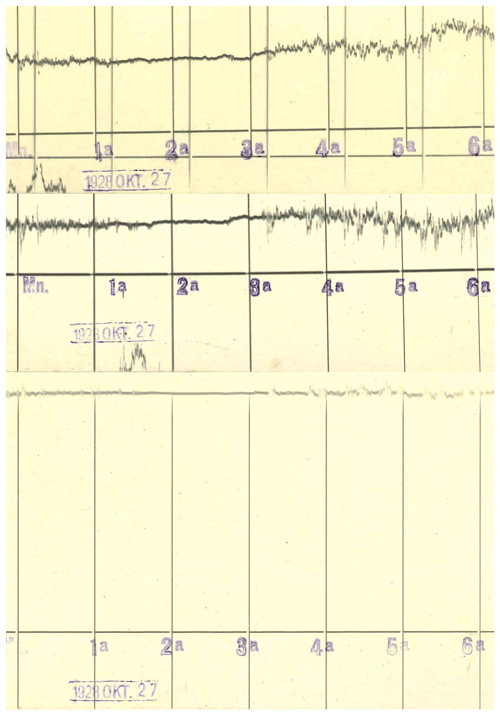
Figure 10Potsdam Observatory photographic recordings of the horizontal intensity (top), declination (middle) and vertical intensity (bottom) of the time interval of 27 October 1928 at 00:00 till 27 October 1928 at 06:00 (Greenwich civil mean time), showing the disturbing effect of the Berlin suburban railway service. Source: Helmholtz Centre Potsdam – GFZ.
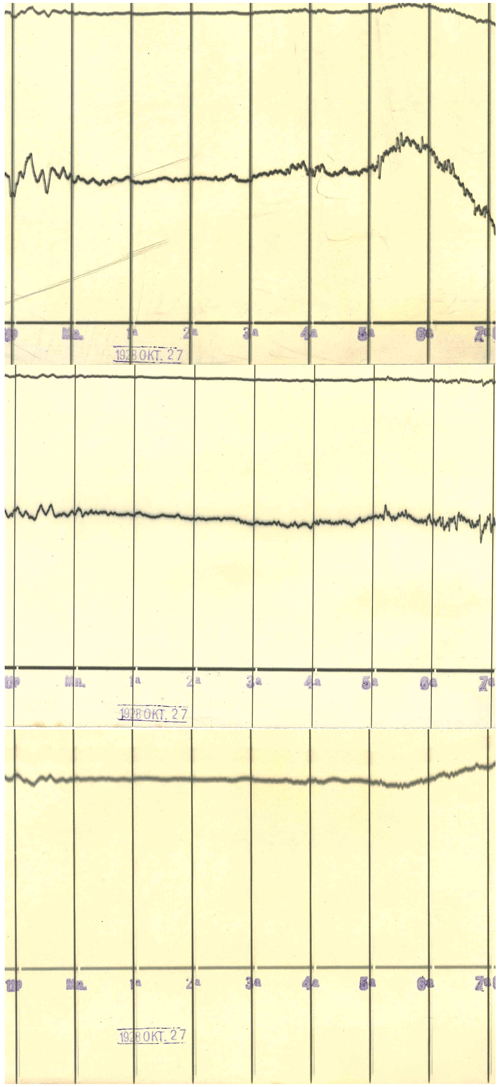
Figure 11Seddin Observatory photographic recordings of the north (top), east (middle) and vertical component (bottom) of the time interval of 26 October 1928 at 23:00 till 27 October 1928 at 07:00 (Greenwich civil mean time) showing the disturbing effect of the Berlin suburban railway service. Source: Helmholtz Centre Potsdam – GFZ.
Figure 11 shows the influence of the electric trains of the Berlin suburban railway on the Seddin recordings of the time interval of 26 October 1928 at 23:00 till 27 October 1928 at 07:00 (Greenwich civil mean time). The noise caused by the leakage currents is smaller than on the Potsdam Observatory but clearly visible. Such disturbed recordings are not acceptable on a permanent basis. It was necessary to construct the new Niemegk Observatory as soon as possible (Linthe, 2023b). Only in the course of 1931 did the new observatory become functioning. In fact, it was intended that the Seddin and Niemegk observatories would be operated for a suitable time in parallel to ensure a smooth changeover. The time period of only 1 year provided this opportunity. On 9 May 1932, the last absolute measurements took place in Seddin. The next day, the variometer recordings were terminated (Nippoldt, 1933).
2.3.2 Affiliation and directors of the observatory
The Seddin Observatory was affiliated, during its complete existence, to the magnetic department of the Potsdam Meteorological Magnetic Observatory of the Royal Prussian Meteorological Institute Berlin. In 1919, the institute was renamed the “Prussian Meteorological Institute Berlin”.
Adolf Schmidt (1860–1944) became the director of the Potsdam Observatory in 1902. He kept the director's position until his retirement on 1 October 1928. Alfred Nippoldt (1874–1936) took over his position. The portraits of both persons can be found in Linthe (2023a).
Otto Toepfer (1845–1914) founded his mechanical workshop in 1873 in Potsdam. He constructed scientific instruments for different Potsdam institutes. In 1896, Otto Toepfer handed over the supervision of the company to his son Reinhold Toepfer (1873–1951). Due to financial problems, the company was taken over in 1919 by Carl Bamberg's “Werkstätten für Präzisions-Mechanik und Optik” (workshops for precision mechanics and optics), which in 1921 was renamed “Askania Werke AG”.
The Seddin Observatory further purchased instruments from the mechanical workshop owned by Gustav Schulze, Potsdam. Unfortunately information about this company could not be found.
The paper is based on information given in the cited references. No further data were used.
The author has declared that there are no competing interests.
Publisher’s note: Copernicus Publications remains neutral with regard to jurisdictional claims in published maps and institutional affiliations.
This article is part of the special issue “History of geophysical institutes and observatories”. It is not associated with a conference.
Kristian Schlegel strongly encouraged me to write this paper. I am very thankful to him for his patience. I further thank the Helmholtz Centre Potsdam, the GFZ German Research Centre for Geosciences, which rendered it possible for me to write the paper using its resources. I am especially thankful to Jürgen Matzka, group leader of the Geomagnetic Observatories for Geomagnetism Section of the GFZ, for giving me the opportunity to work at the Niemegk Adolf Schmidt Geomagnetic Observatory. Since my official retirement at the end of 2014, I have had the chance to use an office, a computer and all the observatory publications to collect the necessary information.
This paper was edited by Kristian Schlegel and reviewed by Gregory Good and two anonymous referees.
Fanselau, G.: Ergebnisse der magnetischen Beobachtungen am Observatorium Seddin – Niemegk, Zusammenfassung bisher noch nicht veröffentlichter Tabellen der Stundenmittelwerte für die Jahre 1917 bis 1931 und 1934, Deutsche Akademie der Wissenschaften zu Berlin, Geomagnetisches Institut Potsdam, Akademie-Verlag, Berlin, 1959.
Linthe, H.-J.: History of the Potsdam, Seddin and Niemegk geomagnetic observatories – Part 1: Potsdam, Hist. Geo Space. Sci., 14, 23–31, https://doi.org/10.5194/hgss-14-23-2023, 2023a.
Linthe, H.-J.: History of the Potsdam, Seddin and Niemegk Geomagnetic Observatories – Part 3: Niemegk, Hist. Geo Space. Sci., in preparation, 2023b.
Nippoldt, A.: Verlegung der magnetischen Observatorien von Potsdam und Seddin wegen Elektrisierung der Vorortbahnen. Bericht über die Tätigkeit des Preußischen Meteorologischen Instituts im Jahre 1928, Veröffentlichung des Preußischen Meteorologischen Instituts Nr. 362, Julius Springer, Berlin, 52–60, 1929.
Nippoldt, A.: Ergebnisse der magnetischen Beobachtungen in Potsdam und Seddin im Jahre 1929, Veröffentlichungen des Preußischen Meteorologischen Instituts Nr. 383, Julius Springer, Berlin, 3–35, 1931.
Nippoldt, A.: Magnetische Arbeiten, in: Bericht über die Tätigkeit des Preußischen Meteorologischen Instituts im Jahre 1932 erstattet vom Direktor, Veröffentlichung des Preußischen Meteorologischen Instituts Nr. 395, Julius Springer, Berlin, 44–49, 1933.
Nippoldt, A.: Ergebnisse der magnetischen Beobachtungen in Potsdam und Seddin im Jahre 1931, Magnetisches Observatorium der Universität Berlin in Potsdam-Niemegk, Julius Springer, Berlin, 3–52, 1934.
Schmidt, A.: Ergebnisse der magnetischen Beobachtungen des Observatoriums in Potsdam im Jahre 1905, Veröffentlichungen des Königlich Preußischen Meteorologischen Instituts Nr. 196, Behrend & Co., Berlin, 1–82, 1908.
Schmidt, A.: Ergebnisse der magnetischen Beobachtungen des Observatoriums in Potsdam und Seddin im Jahre 1908, Veröffentlichungen des Königlich Preußischen Meteorologischen Instituts Nr. 225, Behrend & Co., Berlin, 1–97, 1910.
Venske, O.: Die Registrierungen an der Hülfsstation bei Seddin, Ergebnisse der magnetischen Beobachtungen in Potsdam im Jahre 1906, Veröffentlichungen des Königlich Preußischen Meteorologischen Instituts Nr. 211, Behrend & Co., Berlin, 19–25, 1909.
Venske, O.: Arbeiten und Beobachtungen in Seddin, Ergebnisse der magnetischen Beobachtungen in Potsdam und Seddin im Jahre 1925, Veröffentlichungen des Preußischen Meteorologischen Instituts Nr. 351, Julius Springer, Berlin, 10–14, 1927.





